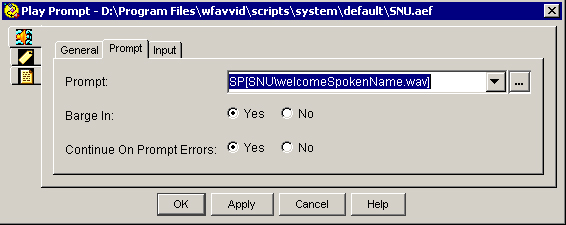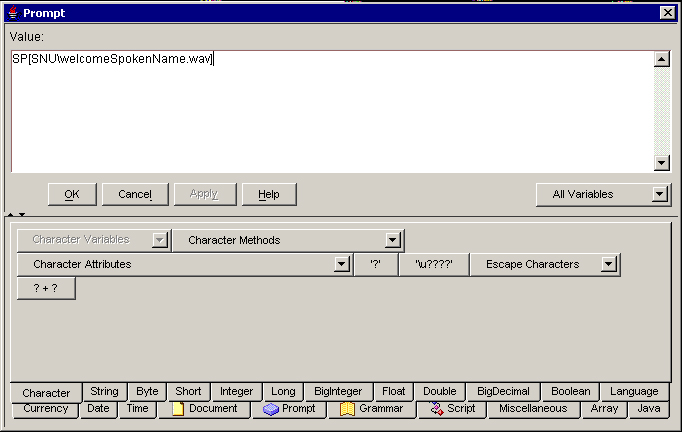The Play Prompt Step
Continue the SNU.aef script by dragging a Play Prompt step from the Media palette to the Design pane.
Next, configure this Play Prompt step to play back to the caller the system prompt SP[SNU\welcomeSpokenName.wav], which plays “Welcome to the Cisco Spoken Name Upload Application.”
Figure shows the configured Prompt tab of the Play Prompt customizer window.

Note | When developing scripts that prompt callers, remember to accommodate the needs of hearing-impaired customers. To make your application fully accessible to these callers, set up scripts to interact with devices such as a Telecommunications Relay Service (TRS) or Telecommunications Device for the Deaf (TTY/TDD). |
Configure the Play Prompt step as follows:
-
General tab
-
Contact—Triggering Contact
The step operates on the contact that triggers the execution of the script.
-
Interruptible—No
External events cannot interrupt the playing of the prompt.
-
-
Prompt tab
-
Prompt—SP[SNU\welcomeSpokenName.wav]
SNU\welcomeSpokenName.wav is the prompt that the Play Prompt step plays back to welcome the caller.
Because the .wav file that serves as the welcoming prompt already exists as a system prompt, you do not need to define it as a variable; instead enter the prompt directly by clicking the Expression Editor button and entering the name in the text field of the dialog box that appears.
Prompt Address Dialog Box (accessed by Expression Editor button)  Note
NoteFor more information about using the Expression Editor, see Chapter 2, “How To Use the Cisco Unified CCX Editor.”
-
Barge in—Yes
The caller can interrupt the prompt playback.
-
Continue on Prompt Errors—Yes
In the event of a prompt error, the script continues to play back the next prompt in the sequence or waits for caller input.
-
-
Input tab
-
Flush Input Buffer—Yes
-
The system erases previously entered input before capturing new caller input.
Note | For more information about configuring the Play Prompt step, see the Cisco Unified Contact Center Express Scripting and Development Series: Volume 2, Editor Step Reference Guide. |